How To Bet On Horses: A Beginner’s Guide
How To Bet On Horses: A Beginner’s Guide
With a history dating back to Roman times, horse racing is one of the most popular sports around the globe. It provides engagement, excitement and an action-packed adrenaline rush.
Would the sport be as exciting and popular without horse racing betting being involved?
Highly unlikely! The sports betting industry and in particular, betting on horses is huge these days and worth in excess of an astonishing £4 billion each year in the UK alone.
However, for anybody new to the horse racing scene and betting on horse races, the mountain of information can really get quite daunting. Betting on horse racing comes with its own terminology, a deluge of different types of bets and there’s even betting strategies to consider.
Fear not! This comprehensive guide will walk you through everything you need to know about placing bets on horse racing.
You'll learn what to consider before placing a bet, the types of horse racing bets, how to place the bets and understanding the betting odds.
Horse Racing Basics
It’s important to know at least the basics of betting on horses before you start.
Believe it or not, this can make a massive difference to your betting selections as you gain more experience.
Terminology
The minimum you’ll see when looking at any race will include the following information:
- Post Time: This is the race start time. You need to be aware that sometimes there are delays to the post time.
- Jockey: This is the person that rides the horse in the race.
- Distance: All races are displayed in miles, furlongs and yards (in that order). For info, a furlong is 1/8th of a mile.
- Handicaps: Handicappers are employed by the British Horse Racing Authority. (BHA) to allocate weight handicaps to horses to ensure horses of differing ability can be competitive in each race.
Types of Horse Racing Bets
The amount of different types of horse racing bets available in today’s betting markets is phenomenal. For simplicity, let’s put them into three main categories:
- Win Only: Also known as Single bets, you are betting one horse to win a race.
- Each Way: With Each Way bets, your stake is split in half with one half betting on the horse winning and the other half betting the horse will place. How many places there will be is decided by the bookies but are usually 2, 3 or 4 places.
- Multiples: Bet multiples in horse racing can include anything from a Double bet (2 horses, 1 bet) to a Goliath bet 8 horses, 247 bets). These bets are more suitable for experienced bettors so should be left alone until you fully understand the basics.
Horse Racing Betting Odds
Betting odds are effectively the chance or probability a horse has of winning a race.
The higher the odds, the less likely a horse is to win a race. However, don’t assume the bookies have got it right as there are plenty of occasions when punters have bagged big profits on outsiders winning races.
Whilst the odds indicate the probability of something happening, it’s not always a true representation of it. In order to make profits, bookies skew the odds to their advantage so keep that in mind when looking at your horse selections.
The majority of people are used to seeing odds as fractions. However, the bookies provide the facility to change the odds format if you prefer. So, what odds formats are there?
- Fractional Odds: This is the traditional format used in the UK and will look like 3/1 (for each £1 you bet, you will win £3). Sometimes you will see what’s called ‘Odds on’ and this will look like 1/2. This means that for each £2 you bet, you will win £1.
- Decimal Odds: decimal odds are mainly used in Europe and are arguably the easiest to understand. Using decimal odds also makes odds comparisons much easier as you don’t need to calculate anything. Fractional odds of 2/1 would be 3.0 as decimal odds. Decimal odds are the go to format when it comes to Matched Betting.
- American (Moneyline) Odds: These are the most confusing of all the odds formats. American odds are based on $100 stakes and are shown as a plus or a minus. So, whilst 2/1 (fractional) and 3.0 (decimal) are used in the UK, the American odds would show as +200. For each $100 stake you place, you can win $200.
If you get confused with converting odds or switching from fractional to decimal, you can use the odds conversion table provided by Aceodds.
Not only are betting odds indicative of a horse’s chances of success, they also determine how much money you could win. For example, if you bet £10 on Horse A at odds of 8.0 (7/1) and it won, your returns would be £80. This includes your original stake so your profit would be £70.
Obviously, you want to find the best odds on the market. If you have picked a horse you fancy to win, it’s worth looking at odds comparison sites like Oddschecker. They will provide you with a list of bookmakers and the odds each of them are offering on any given race.
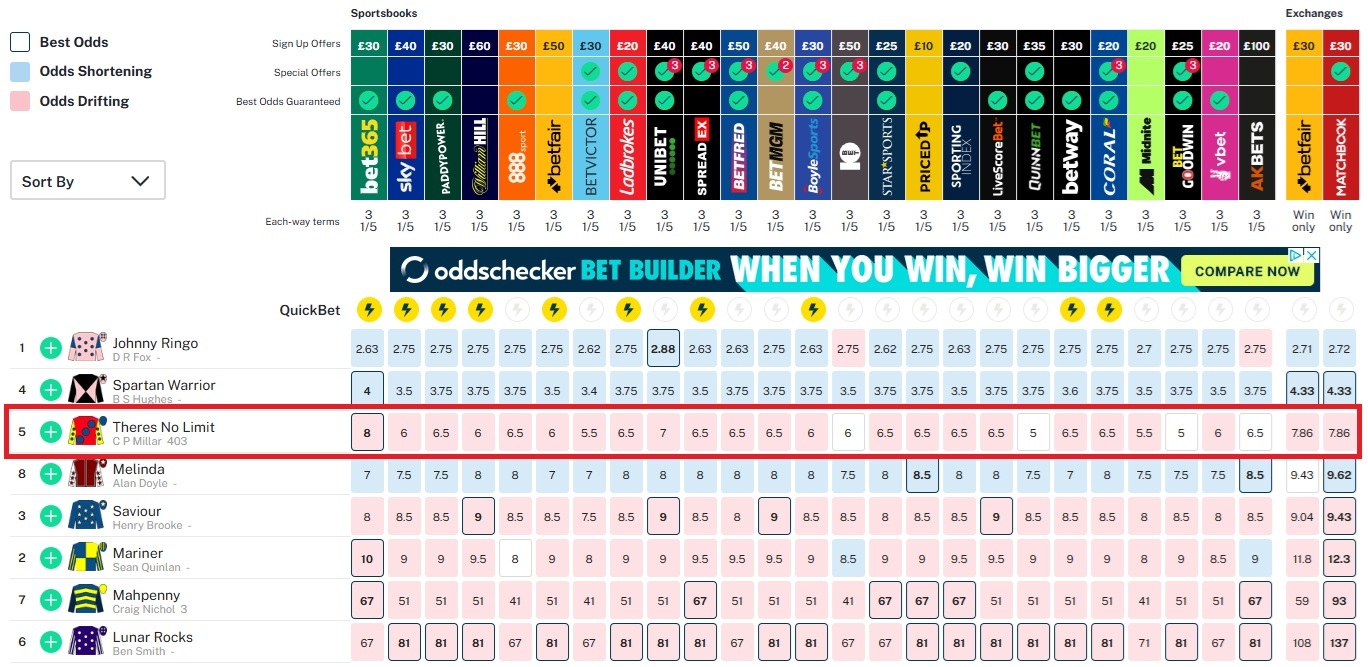
The above example is for an afternoon race at Musselburgh Racecourse. As you can see, the odds for each horse are provided for over twenty bookies. If you wanted to bet on ‘There’s No Limit’ then the best odds are 8.0 (7/1) and are available at Bet365. The other bookies have already dropped the price on the same horse.
Now, you might not want to open accounts with every bookie (unless you’re Matched Betting), but using odds comparison sites can at least identify which bookies are offering the best odds.
If you’d like to get a more in-depth understanding of betting odds, read our Betting Odds article.
Types Of Horse Races
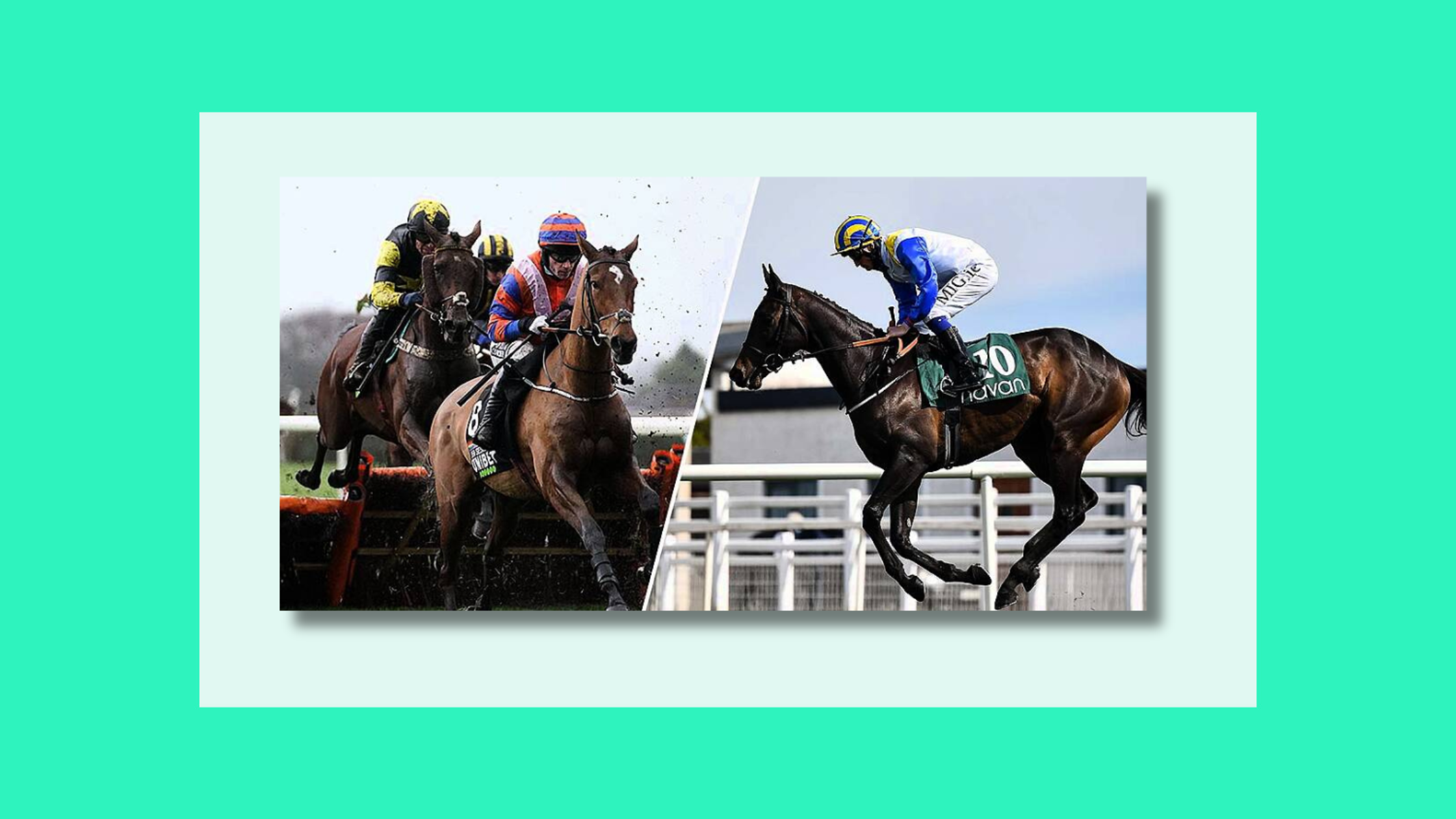
There are two main types of horse racing in the UK, Flat and Jumps. Of course, this is horse racing and nothing is that straight forward. Within each of these two categories there are different types and classes of races.
Flat Races
As you might have guessed, there are no jumps/hurdles in this type of race, just horses running on a flat track from start to finish. As with the two race types (flat and jumps), the Flat races are also split into two with half the races being Handicaps and the other half being Stake races. The list below should help provide a little more clarity:
Group Races
Group races are the better known types of race and the crème de la crème of the racing world. They are split into three classifications, Groups 1, 2 and 3. Group races run throughout the racing calendar to provide races covering different distances at different race courses.
- Group 1: This is the elite class of flat racing and includes Classic races such as the 2,000 Guineas, the Oaks and the St Leger. Group 1 races are a clash of ability and class. In the main, horses of the same gender and age race in Group 1 events. However, the BHA do give weight allowances for three year old horses against older horses. Similar allowances are given to different gender horses.
- Group 2 and 3: These groups take us the next two steps down from Group 1 races. Group 2 and 3 races are calculated the same in terms of weight allowances. However, there are additional penalties (weight) added to horses that have won at equal or higher levels.
Listed Races
Listed races are one step below Group races and have similar handicaps applied. Listed races are used for those horses trying to break through into the Group level racing.
However, make no mistake, Listed races are still considered to be Class 1 races making them great horse races to bet on.
Handicap Races
Most horses compete in Handicap races at some point. After every race, a team of handicappers assess each horse and allocates an official rating. This will go up and down based on their performance in each race.
From there, based on the rating a horse has, a weight handicap is given. Each rating point is equivalent to 1lb. For example, if a horse with a rating of 88 carries 9st 4lbs, a horse with a rating of 90 will carry 9st 6lbs.
Flat Handicap ratings are capped at 110. If a horse has a rating above 110, they then have to move up to Listed races or Group races depending on their rating.
All penalties and handicaps are issued so that the races are as competitive as they can be.
Jump Races
Jump races are also known as National Hunt races and horses that compete in Jump racing must be at least three years old, but many start a little later. Jump races involve obstacles called Hurdles and Fences. Just to clarify, hurdles are obstacles that are at least 3ft 6in and fences are more sturdy and are at least 4ft 6in high. As with Flat racing, there are different types of Jump races so let’s have a look:
National Hunt Flat Races
You might have noticed the word ‘Flat’ in the title of this one. That’s because the horses don’t jump any obstacles in this type of race. Also referred to as Bumpers, these races are used to nurture horses that have been bred for Jump racing and are expected to race over fences or hurdles in the future.
Novice Hurdling
Horses that haven’t won a hurdles race take part in Novice Hurdle races. Once a horse wins a Novice Hurdle race, it’s allowed to compete at the same level until the end of the racing season.
Hurdling
This is the next step up from Novice Hurdling and horses compete in either graded or handicapped races. Horses that take part in these races are often previous flat race horses looking to move into Jump racing. Jump racing horses also compete in Hurdling races as practice for moving on to Chase races (Fences).
Novice Chasing
The same as the Novice Hurdling division but over fences instead. The same rules apply in terms of horse who have not won a race previously over fences. Once a horse wins a Novice Chase race, they can compete at the same level until the end of the current season.
Chasing
Chase races are the higher level of races over fences. The rules are the same as Flat racing but instead of being in Groups, they are put into Grade1, 2 and 3 races. Grade 1 races include the Cheltenham Gold Cup and the Champion Hurdle. Don’t be put off by the lower grade races as they can be equally as good. In fact, the Grand National is actually a Grade 3 Chase race.
Placing Horse Racing Bets
That’s the pre-amble out the way so let’s look at how you actually place horse racing bets. The truth is that we could be here all day if we showed you how to place every type of bet.
Therefore, we’ll just cover off the basics of Single bets, Each Way bets and a Multiple bet.
Single Bets On Horse Racing
As mentioned earlier, with a Single bet you are just picking one horse to win a particular race. This is the most straight-forward type of bet you can place in horse racing or any other sports come to that.
So, in order to find a horse to back, head to the racing section on the bookie website and decide which horse you want to back. For this example, we have chosen The Jukebox Man in the 1.55pm race at Newbury.
You just need to click on the odds of the horse you want and the bet slip will open up as below:
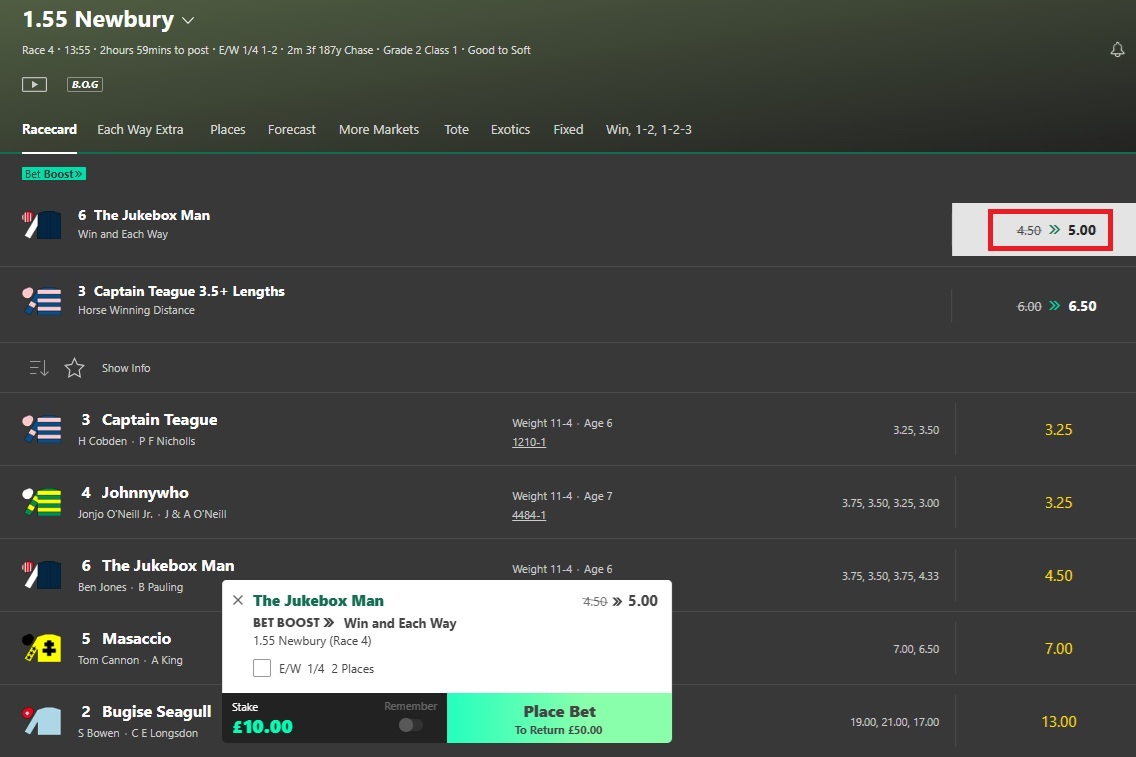
You then enter the stake amount you want to place and click on the ‘Place Bet’ button. That’s it, your bet is placed. We did say the Single bets were easy to place!
If The Jukebox Man wins, what do you get back?
- £10 (stake) x 5.0 (4/1) (odds) = £50 returns less your £10 stake = £40 profit.
You might have noticed that Bet365 boosted the price of The Jukebox Man to 5.0 (4/1). You should always keep an eye out for any price boosts offered by the bookies as they can provide you with extra value bets.
The main reason Then Jukebox Man was chosen in this example was to show you the value available from Bet Boosts.
Remember the Oddschecker website that shows you the odds on offer from a host of bookies? Let’s have a look at the odds showing on Oddschecker when the example bet on The Jukebox man was placed:
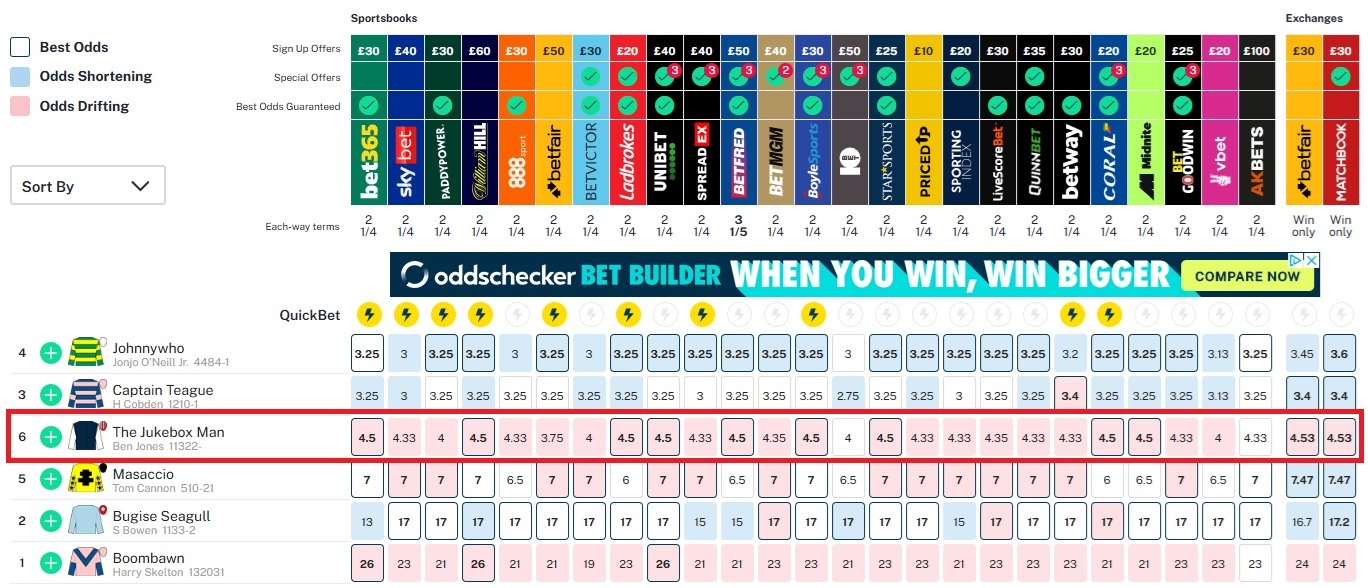
So, at the time the bet was placed on The Jukebox Man, Bet365 had the highest odds of 4.5 (7/2), along with a handful of the other bookies. All the other bookies had lower odds. However, thanks to the Bet Boost on offer from Bet365, our odds were even higher at 5.0 (4/1). Based on these odds, you can see the value we are getting from the boosted price.
NOTE – The Oddschecker website doesn’t include any price boosts in the displayed odds so always check both the Oddschecker odds and the bookies website for any boosts that might be on offer.
Each Way Bets On Horse Racing
The process to place Each Way bets is almost identical to placing Single bets. Find the race and horse you want to back and select the horse to add it to your bet slip.
However, this time, when you enter your stake, you need to tick the EW selection box as highlighted below and then place the bet:

Don’t forget, you’re splitting your bet into two with Each Way bets. Therefore, the stake you enter will double to £20 as highlighted.
As we did with the Single bet, we have chosen the boosted odds of Hermino AA because it appears to offer good value when compared with some of the other bookies. When checking Oddschecker (image below), you can see the highest odds on offer at all the bookies is 8.0 (7/1) but Bet365 have boosted the odds to 9.0 (8/1).
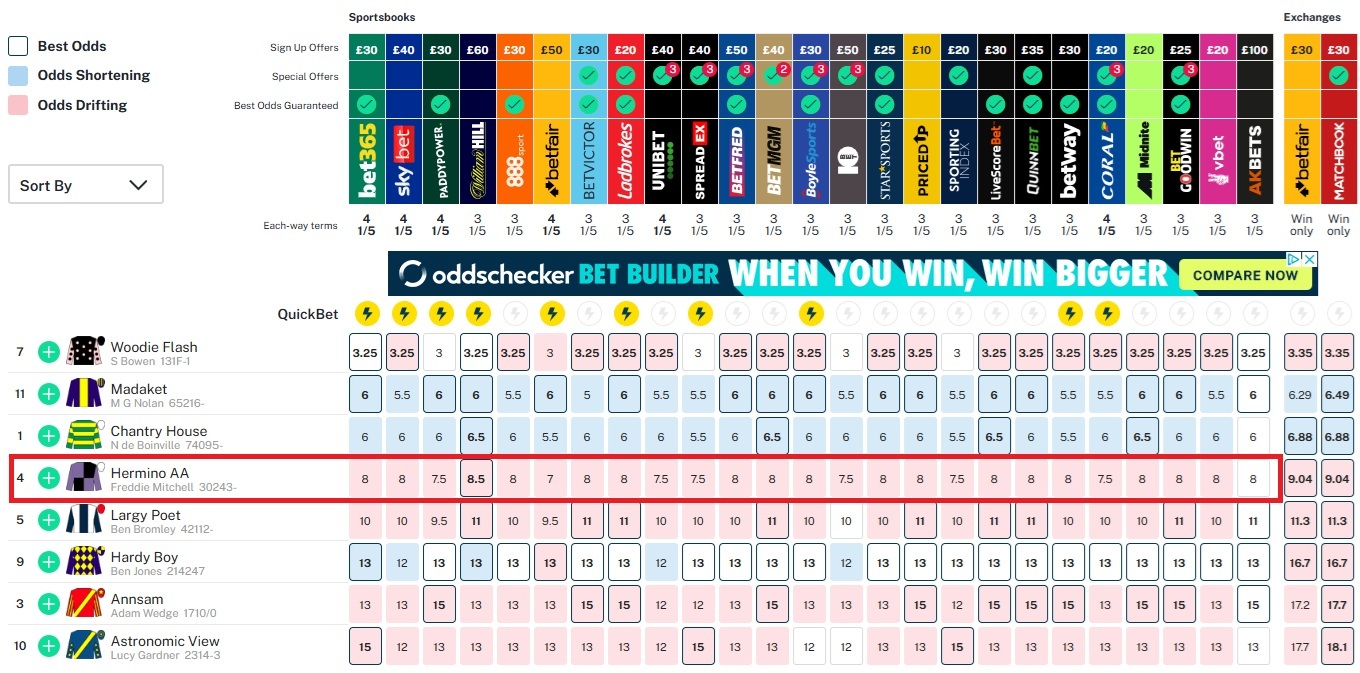
Obviously by doing the bet Each Way, you’re increasing your chances of getting some returns because the places are involved.
Firstly, you need know the place terms. In this case, the place terms are 1/5 of the win odds that are 9.0 (8/1). This means the place odds are 8 x 0.2 (1/5 of 8) = 1.6. So, what might you get back?
Outcome One: Hermino AA wins
- £116 returned less the £20 stake = £96 profit
Outcome Two: Hermino AA places
- £26 returned less the £20 stake = £6 profit
Outcome Three: Hermino AA doesn’t win or place
- You lose £20
Extra Places – A lot of bookies offer an extra place or two to customers placing Each Way bets. This provides fantastic value as your chances of getting your horse placed are increased. You can find out more information about how to profit from this offer in our Extra Places article.
Multiple Bets on Horse races
Firstly, placing multiple types of horse bets is something novice bettors need to be careful with. These are more suited to experienced bettors due to the combinations and complexities involved.
The betting options with multiple bets are incredible but can be very daunting when you use bets with higher bet combinations. These include Tricast bets, Yankee bets, Lucky 15 bets, and Heinz bets.
As this article is aimed at beginners, let’s take a look at one of the easier multiple bets, the Patent bet.
To place a Patent bet you need to choose three horses from three different races. The three horses chosen then create one bet that contains seven bet combinations as follows:
| Single 1 | Horse 1 to Win |
| Single 2 | Horse 2 to Win |
| Single 3 | Horse 3 to Win |
| Double 1 | Horses 1 & 2 to Win |
| Double 2 | Horses 1 & 3 to Win |
| Double 3 | Horses 2 & 3 to Win |
| Treble | Horses 1, 2 & 3 to Win |
Each of the above seven bets are treated individually so all is not lost of all three horses don’t win.
On to placing a Patent bet. Have a look through the racecards and pick your three horses. Remember, they need to be from three different races.
Once you have added all three you will see something similar to the below:

Enter your stake and place the bet and you’re all done. Remember, your stake applies to each of the bet combinations, so the stake multiplies by 7 times.
If you would like to know more about the other types of multiple bets, have a read of our Types of Bets article.
How To Research And Pick Your Horses
Betting blindly relies on luck to get results and you might get lucky now and again but it’s not a practice to rely on.
The best thing you can do to give yourself the best chance of winning is to carry out research on horse form.
The research can include looking at track conditions along with horse, jockey and trainer form. All of this information is readily available on a daily basis.
Some bookies provide basic form information including how the horse has performed in its last few races, its age, weight and who the trainer is.
Alternatively, the Racing Post are the Oracle of horse racing information and provide a crazy level of information.
So, what does this information look like?
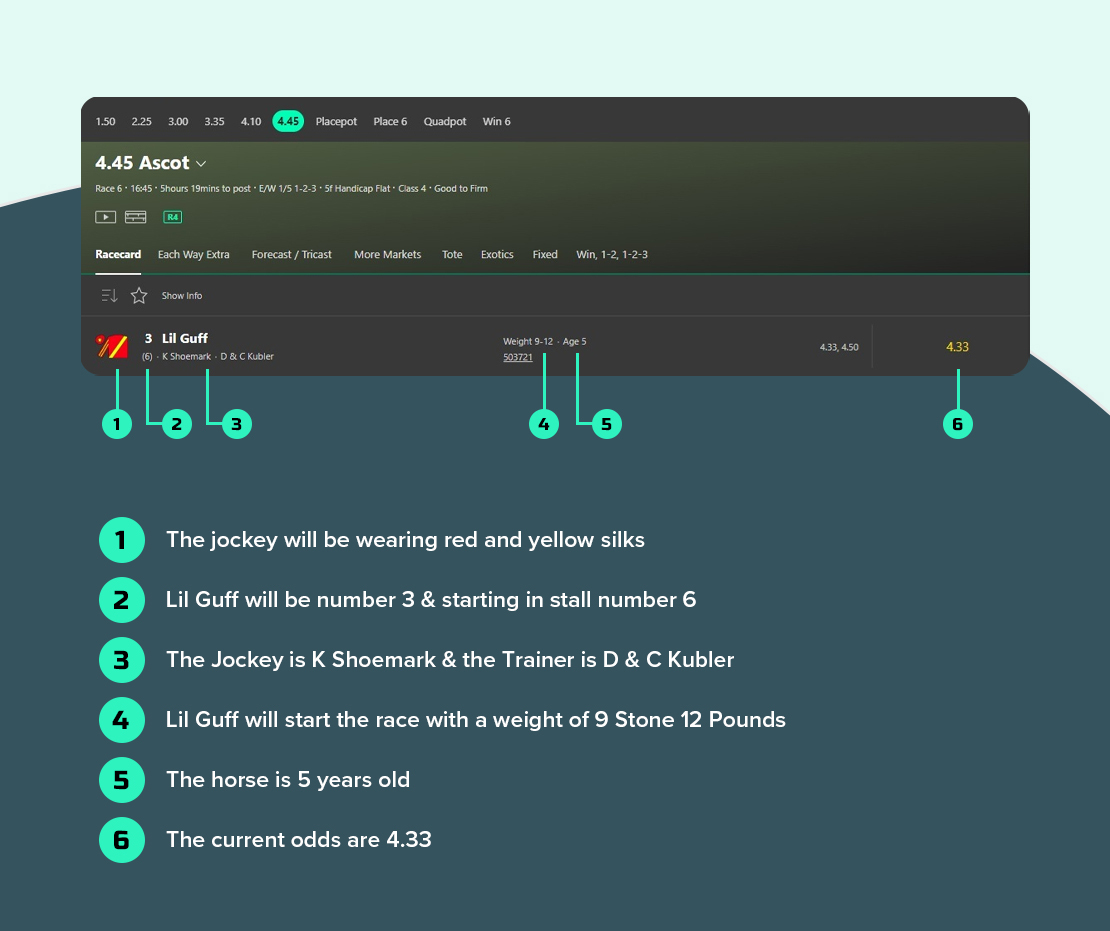
The above image highlights some of the key elements to the horse but in addition to this, at the top of the racecard, you can see the track condition, the Each Way places and race distance.
The recent form of a horse is usually shown as a sequence of numbers advising where it finished in various races. In the above Bet365 example, those numbers are shown the below the Weight details. By clicking on the horse name or the form numbers, more information will be provided like below:
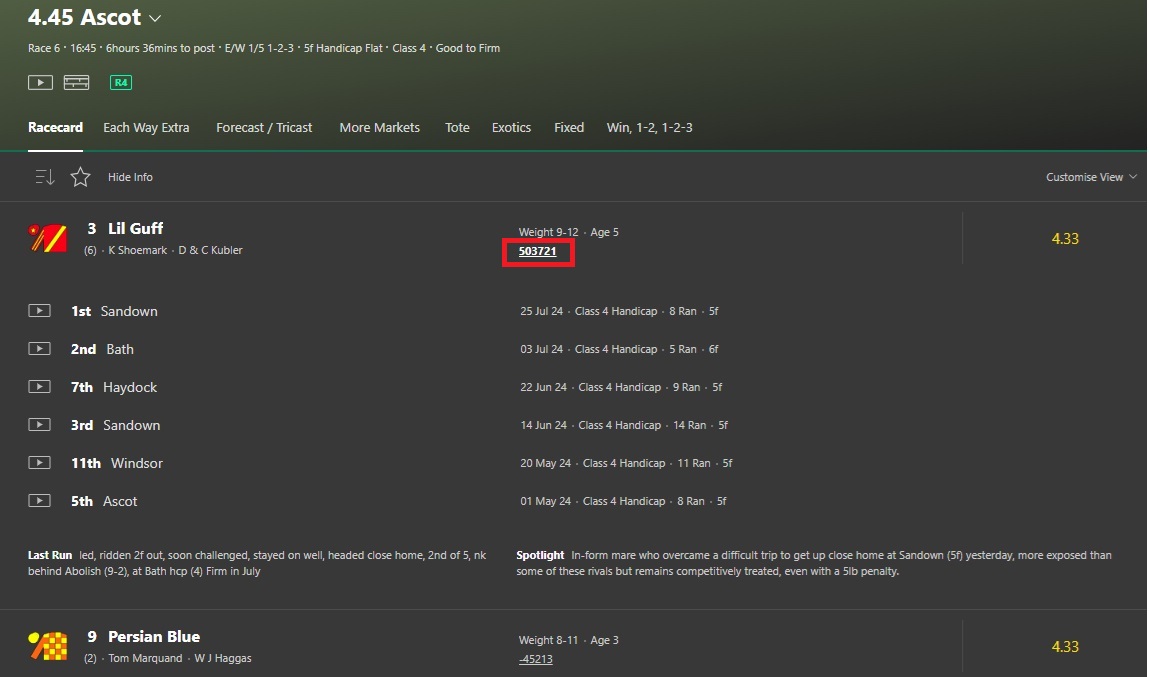
As you can see, Bet365 provide the race form of horses for the previous six races. This information tells you when the race was, where it finished and the distance of the race. Please Note – If then form shows a zero, this means it didn’t finish in the top 9 places.
We mentioned the Racing Post before so let’s have a look at what information they provide for the same horse:
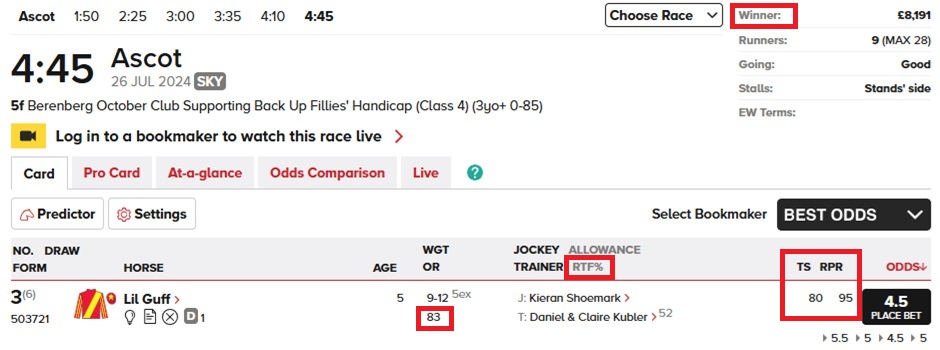
The Racing Post provide the basic information that Bet365 provide but there’s plenty of additional information:
- Winner: The race prize money
- TS (Top Speed Rating): This measures the performance against the course standard time after weight and age have been factored in
- OR (official Rating): This is determined by the BHA handicappers
- RPR: This is rating exclusively determined by the Racing Post
- RTF%: This provides details of how many horses have run to form for that trainer in the last 16 days
This information is just the tip of the iceberg though. As you start clicking around on the racecards, you will find an unbelievable amount of information on horse, jockeys and trainers.
Once you’re a little more comfortable and experienced at horse racing betting, you might like to do a deep dive on studying horse racing form. The truth is, there’s a vault of information available to help you pick your horse racing bets but the majority of casual bettors don’t use a fraction of it. This amount of information is usually utilised by professional gamblers.
The Outplayed How to Read Horse Racing Form article will provide all the information you need to know.
Where Can You Bet On Horses?

In the UK, you’re realistically looking at three options for placing bets on horses:
On-Track Betting: Going to the races can be great fun as you get to engage in the atmosphere and excitement. Part of that experience is dealing with the on-track bookies that each have their own betting stands. Each of them will have the odds up on boards of some description. It’s up to you to find the bookie with the best odds.
Off-Track Betting: This is placing your bets in a high street bookies shop. The amount of physical betting shops has declined over the years but that’s no shock given the online betting options available. Whilst the amount of betting shops does decrease each year, there are still just short of 6,000 serving the betting community.
Online Betting: Placing online bets is how the majority of bets are placed these days and continues to grow. Bookies have invested a lot of time and money in delivering the best online betting facilities to customers. These options are available on both websites and mobile apps. Being able to place bets online is very easy and such a convenient option for bettors. With pretty much all of the bookies offering sign up offers and bonuses, it’s easy to see why so many people use this option.
Tips For Betting On Horses
Betting successfully on horse racing is often a game of chance and there isn’t a strategy that can guarantee results. However, it’s possible to increase your chances of success by considering the following:
- Start Slowly: If you’re new to betting on horses, begin with the simple bets and keep your stakes low whilst you learn.
- Offers: Keep an eye out for offers and bonuses as they can enhance your chances of winning. Price Boosts and Extra Place races are just two things to look out for.
- Research: Make sure you study the racecards before placing your bets. See if a particular horse, jockey or trainer has a high success rate at specific race courses.
- Check Your Stakes: You’re unlikely to make mistakes on simple bets such as Singles. However, when you move on to more complex bets, they tend to have more combinations and multiply your stakes. Always check before you place the bet or it could be costly.
- Professional Help: Tipsters offer no guarantees. However, it’s worth checking what the professionals have to say about each race and any NAP they might have suggested. If they have confidence in it, see if you can find any further information to substantiate it.
- Compare Odds: Use industry websites like Oddschecker to see who is offering the best odds on a horse you fancy to win a race.
Conclusion
Horse racing is a fun and exciting sport that is massive in the UK now and placing horse racing bets requires a strategy, analysis and of course a bit of luck.
Getting to grips with the basics including the types of bets available, understanding what to research and using strategies can provide you with the tools to needed to increase your chances of success.
Are you ready to get started? Study the racecards you’re interested in and get picking your horses.
Remember to stick to your budget and never chase any loses.
Many punters enjoy reducing the risk of betting on horses by using bookmaker promotions to do Cheltenham Matched Betting and Royal Ascot Matched Betting.
Updated: 12 Jun 2025
The Author
Paul brings over four years of Matched Betting experience to Outplayed. His extensive background in financial services and e-commerce, combined with his expertise in online marketing and Matched Betting, makes him a valuable asset to the team.

